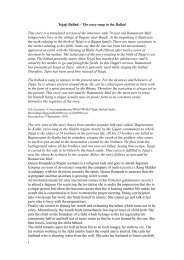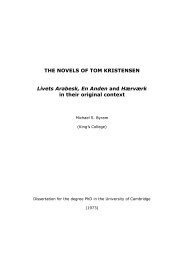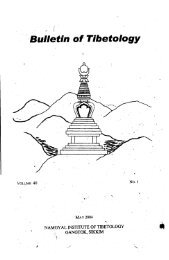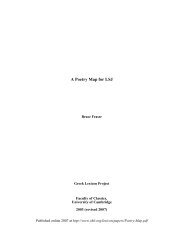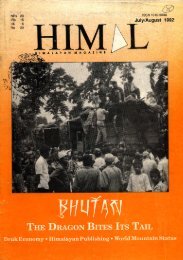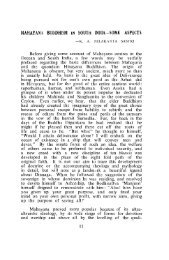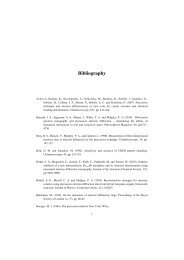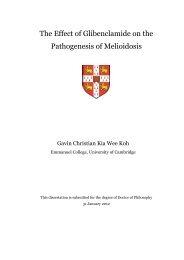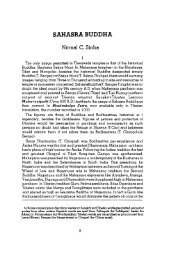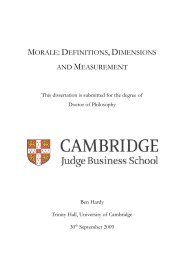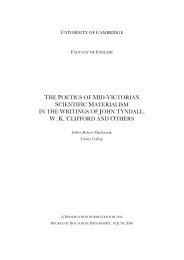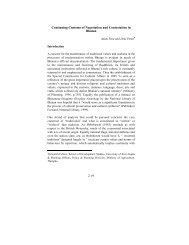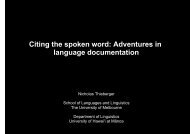The Crusades, the Genoese and the Latin East - DSpace at ...
The Crusades, the Genoese and the Latin East - DSpace at ...
The Crusades, the Genoese and the Latin East - DSpace at ...
You also want an ePaper? Increase the reach of your titles
YUMPU automatically turns print PDFs into web optimized ePapers that Google loves.
5 <strong>The</strong> <strong>Genoese</strong> communities in <strong>the</strong> kingdom of Jerusalem<br />
This chapter is about <strong>the</strong> <strong>Genoese</strong> who lived in <strong>the</strong> crusader kingdom of Jerusalem after <strong>the</strong> war<br />
of 1187. This topic is rel<strong>at</strong>ed to many issues already discussed in this <strong>the</strong>sis. For example, <strong>the</strong><br />
<strong>Genoese</strong> merchants <strong>and</strong> crusaders who sailed across <strong>the</strong> Mediterranean <strong>at</strong> <strong>the</strong> time of <strong>the</strong> crusades<br />
were <strong>at</strong> <strong>the</strong> centre of previous chapters. However, <strong>the</strong> same people also travelled through <strong>the</strong> ports<br />
of <strong>the</strong> kingdom of Jerusalem <strong>and</strong> often resided in <strong>the</strong> <strong>Genoese</strong> quarters of those towns. Travelling<br />
merchants lived in <strong>the</strong> commune's loggia or rented o<strong>the</strong>r available accommod<strong>at</strong>ion. Rental ad<br />
passagium was usually for several months between <strong>the</strong> spring <strong>and</strong> <strong>the</strong> autumn sailing periods.<br />
O<strong>the</strong>r merchants stayed longer, for a year or more S12<br />
<strong>The</strong>se travelling merchants are not <strong>the</strong> direct<br />
subject of this chapter, but it is not always easy to distinguish between <strong>the</strong> various groups of<br />
people, <strong>the</strong> temporary residents <strong>and</strong> <strong>the</strong> permanent inhabitants of <strong>the</strong> <strong>L<strong>at</strong>in</strong> <strong>East</strong>. This problem is a<br />
major obstacle in <strong>the</strong> study of <strong>the</strong> Italian settlements in <strong>the</strong> <strong>L<strong>at</strong>in</strong> <strong>East</strong> <strong>and</strong> it has been discussed on<br />
various occasions in <strong>the</strong> historiography. Recently, Marie-Luise Favreau-Lile encountered this<br />
problem in her study of <strong>the</strong> Italians in <strong>the</strong> first kingdom of Jerusalem. 5 3<br />
Indeed, <strong>the</strong> <strong>Genoese</strong> who settled in <strong>the</strong> <strong>L<strong>at</strong>in</strong> <strong>East</strong> st<strong>and</strong> <strong>at</strong> <strong>the</strong> core of <strong>the</strong> discussion in<br />
<strong>the</strong> current chapter. This social group will be examined here during a time of major political <strong>and</strong><br />
social changes, a result of <strong>the</strong> Christian defe<strong>at</strong> <strong>at</strong> H<strong>at</strong>tin <strong>and</strong> <strong>the</strong> fall of <strong>the</strong> first kingdom of<br />
Jerusalem. In wh<strong>at</strong> ways were <strong>the</strong> <strong>Genoese</strong> inhabitants of <strong>the</strong> <strong>L<strong>at</strong>in</strong> <strong>East</strong> part of <strong>the</strong> local <strong>L<strong>at</strong>in</strong><br />
society, <strong>and</strong> to wh<strong>at</strong> degree did <strong>the</strong>y perceived <strong>the</strong>mselves as part of <strong>the</strong> cities <strong>and</strong> communes<br />
<strong>the</strong>y left back in Italy? Chapter Four discussed <strong>the</strong> case of <strong>the</strong> Embriaco family th<strong>at</strong> settled <strong>and</strong><br />
governed <strong>the</strong> seaport town of Byblos. It was demonstr<strong>at</strong>ed th<strong>at</strong> this family eventually broke its<br />
ties with Genoa <strong>and</strong> integr<strong>at</strong>ed into <strong>the</strong> local aristocracy. Is it possible to identify a similar process<br />
in <strong>the</strong> case of <strong>the</strong> <strong>Genoese</strong> communities th<strong>at</strong> lived in towns inside <strong>the</strong> kingdom of Jerusalem?<br />
Wh<strong>at</strong> percentage of <strong>the</strong> <strong>Genoese</strong> popul<strong>at</strong>ion in <strong>the</strong> <strong>L<strong>at</strong>in</strong> <strong>East</strong> settled permanently in <strong>the</strong> crusader<br />
st<strong>at</strong>es?<br />
<strong>The</strong> year 1187 is <strong>the</strong> starting point of <strong>the</strong> current study. <strong>The</strong> fall of Acre in th<strong>at</strong> year<br />
brought an end to <strong>the</strong> <strong>Genoese</strong> settlement within <strong>the</strong> kingdom of Jerusalem, which meant a gre<strong>at</strong><br />
loss of possessions. Even more remarkable was <strong>the</strong> fact th<strong>at</strong> it marked an end to <strong>the</strong> <strong>Genoese</strong><br />
privileged-st<strong>at</strong>us as merchants because this st<strong>at</strong>us was limited to Acre. It was an overwhelming<br />
change for <strong>the</strong> <strong>Genoese</strong> <strong>and</strong> it could have spelled a complete end for th<strong>at</strong> commune in <strong>the</strong> <strong>L<strong>at</strong>in</strong><br />
512<br />
On <strong>the</strong> different rental options see Robert Kool, `<strong>The</strong> <strong>Genoese</strong> Quarter in Thirteenth-Century Acre: A<br />
Reinterpret<strong>at</strong>ion of Its Layout', Atiqot 31 (1997), pp. 187-188.<br />
513 Marie-Luise Favreau-Lilie, Die Italiener im Heiligen L<strong>and</strong>.<br />
- von ersten Kreuzzug bis zum Tode<br />
Heinrichs von Champagne (1098-1197) (Amsterdam, 1989), p. 498. See more about <strong>the</strong> different<br />
approaches to this problem in <strong>the</strong> following section of sources <strong>and</strong> scholarship.<br />
144



